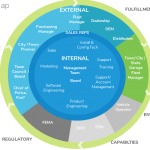Personas
Influenced By: Stakeholder Map, Interviews
Documentation Influences: Workflows, Journey Maps,
Major Influences: User Experience, Customer Experience, Content Strategy, Marketing
Personas are fictitious representations of types of actors within a system. They help us understand motivations and needs from a empathetic viewpoint of the actor, their current situation, and their demographic and ethnographic profile.
Personas are living documents that are updated over time to reflect new technology, new channel usage and availability, perhaps new concerns about new regulatory or tax changes for customers. Well written personas depict individuals that, for the most part, stand the test of time. They are meant to be referred to projects large and small, not started over.
Parts of a Persona:
Over fifteen years, I’ve modified my persona format a great deal. I now include more specific information about technology behavior and have move away from the flawed, yet still mentioned idea that persona information should never consist of more than one page. Someone started this believe long ago and it stuck, but it’s an unnecessary limitation. When presenting personas, when printing them on large scale or distributing them to a wide audience limitation may help with quick consumption. Yet, in-depth personas are worthwhile to Marketing, Research and Strategy teams who need more detail for their work, decision making and measures of success.
Channel Usage:
Call center, Website, Facebook, Instagram, Twitter, other social channels.
As far as social channels, this used to be a comical checkpoint. “This person is young, they are more likely to use SOCIAL CHANNELS.” Social channel specifics help to define a content and media strategy that can save money in production and efforts, as well as timing for posts and frequency. Which social channels are used among your personas and audience is an important factor.
Summary:
Who is the persona? What is their age, gender, other demographics that are of matter such as income, marital status, whether or not they have children, their job title and function. All of these factors may apply or just some. You should think of the summary as a way to understand the persona and forces that may make them make decisions. A mother purchasing a vacation package might think very differently than a single man. A Chief Financial Officer may make software purchasing decisions for a company differently than a Developer. Young, newly graduated alumni may have very different needs for information from their college than alumni in their sixties. The goal is to identify a cast of actors who represent the different types of people involved without getting too minute with unneeded detail or too broad with unhelpful categories (customer and employee).
Quote:
If you had to sum up the thoughts and needs of the persona in one way, what would it be? This should be a short sentence, two max. The quote conveys a memorable idea and state of mind. A quote does this conversationally versus a long list of data points. As such we are more able to remember at least the gist of a quote where we may not remember the data points of several personas. You really want your clients to remember the gist of a persona.
Objectives:
- Get a loan
- Buy tickets to a game
- Apply as a student to Great University
- Buy a house
Each persona has a goal. They should be specific. The goal may change by project. But a persona has a specific goal, they don’t want to “have a great customer experience.” What do they want to accomplish, period.
Needs
Along with a goal, personas have related needs. Needs are less tangible aspects of goals. This is where the empathy portion of personas starts to be very evident. Needs have to be expressed realistically, “I need info and I don’t want to get spammed” is very realistic. “I want a relationship with a bank where I can refer friends” is not.
- Understand costs
- Find out if there are other options to surgery
- Options to choose from based on cost
- To feel I’m making the right decision even though I’ve never done this
Roadblocks
Roadblocks are very simply the things that prevent a person from accomplishing their goal. They are vitally important as they are the questions to which an organization must then provide answers and solutions.
- Fear of rejection (school application)
- Money
- So many applications
- Language
- No time
- You said online application, then said I have to call somewhere, I hate calling anywhere, and hate being on hold
- I have to print to sign / need software to sign?
- I need proof your software will not only work well but be successful at my company, it could mean my job, where’s the proof
- Pricing is ambiguous, can I trust this?
- Why do I have to call all over the hospital for multiple appointments and registrations for a single surgery, isn’t this what you do?
Roadblocks can be anything from material needs (cost, time) to annoyances and stress points that can change the mind of the customer about your product. If their first encounter with your system or customer experience is sub-par, how will that translate to your long-term relationship? If an application process is difficult, is it an insight to ongoing transaction in the future?
Opportunities
You have two options. Your next step should be to use your new personas to create key journey maps of high importance to your project.
However, if not creating journey maps for whatever reason, you are not finished with personas until you develop opportunities.
Both journey maps and/or opportunities are brain storming exercises that should be completed as a group effort. You want diverse opinions, possibly from different departments with different views of customers. These take the personas as built and apply them to a single user goal and explore in depth what happens along the way.
Arguments Against Personas
Every so often, there is a battle cry against personas. Personas are sometimes described as unnecessary or wasteful to a project. This is often an argument within a digital product design.
I would agree.
By the time a smaller project scope is determined, it is far past the ideal time for personas. Persona work is part of early overarching strategic efforts for user research. They should not be a distraction to a project in which the path and scope is already determined.
However, should you find yourself about to dive into any portion of product design where personas have not been defined, it is a risk. It means that the user base–your customers–have not been defined. At this point one must ask who they are building the application for? If unknown, how will you sell it? How will you measure success? How will updates and the design of a digital product be evaluated? Rather than arguing against personas, ensure they are defined at the appropriate and most advantageous time to save so many expensive questions too late in the process.











